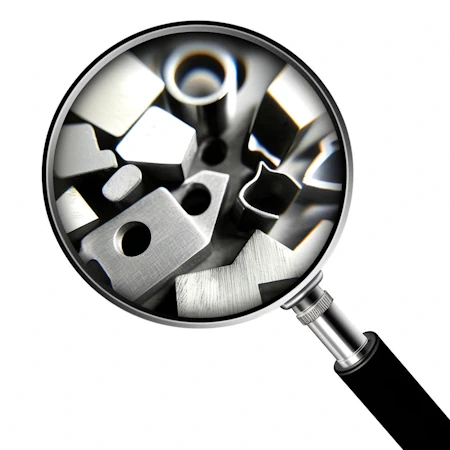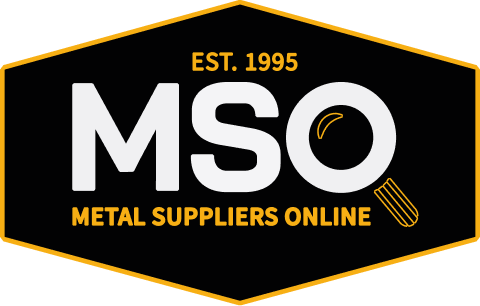Back To Browse
Super Alloy
Super Alloy Haynes Alloy 230 (tm)
Annealing Procedure
Annealing is done at 2225 F followed by rapid cooling or water quenching.
Applications
Gas turbine hot section components such as combustion cans, thermocouple protection tubes, heat exchangers and industrial furnace fixtures and muffles.
Cold Workability
Cold forming may be done using standard tooling although plain carbon tool steels are not recommended for forming as they tend to produce galling. Soft die materials (bronze, zinc alloys, etc.) minimize galling and produce good finishes, but die life is somewhat short. For long production runs the alloy tool steels ( D-2, D-3) and high-speed steels (T-1, M-2, M-10) give good results especially if hard chromium plated to reduce galling.
Tooling should be such as to allow for liberal clearances and radii. Heavy duty lubricants should be used to minimize galling in all forming operations.
Bending of sheet or plate through 180 degrees is generally limited to a bend radius of 1 T for material up to 1/8" thick and 2 T for material thicker than 1/8".
Forgeability
Forging may be done at 2150 F to 1700 F.
Formability
This alloy has good ductility and may be readily formed by all conventional methods. Because the alloy is stronger than regular steel it requires more powerful equipment to accomplish forming. Heavy-duty lubricants should be used during cold forming. It is essential to thoroughly clean the part of all traces of lubricant after forming as embrittlement of the alloy may occur at high temperatures if lubricant is left on.
Hardening Procedure
Hardens by cold working only.
Heat Treatability
The alloy responds to annealing after cold working. It is not hardenable by heat treatment.
Hot Workability
See "Forging".
Machinability
Conventional machining techniques used for iron based alloys may be used. This alloy does work-harden during machining and has higher strength and "gumminess" not typical of steels. Heavy duty machining equipment and tooling should be used to minimize chatter or work-hardening of the alloy ahead of the cutting.
Most any commercial coolant may be used in the machining operations. Water-base coolants are preferred for high speed operations such as turning, grinding, or milling. Heavy lubricants work best for drilling, tapping, broaching or boring.
Turning: Carbide tools are recommended for turning with a continuous cut. High-speed steel tooling should be used for interrupted cuts and for smooth finishing to close tolerance. Tools should have a positive rake angle. Cutting speeds and feeds are in the following ranges:
For High-Speed Steel Tools For Carbide Tooling
Depth Surface Feed Depth Surface Feed
of cut speed in inches of cut speed in inches
inches feet/min. per rev. inches feet/min. per rev.
0.250" 25-35 0.030 0.250" 150-200 0.020
0.050" 50-60 0.010 0.050" 325-375 0.008
Drilling: Steady feed rates must be used to avoid work hardening due to dwelling of the drill on the metal. Rigid set-ups are essential with as short a stub drill as feasible. Heavy-duty, high-speed steel drills with a heavy web are recommended. Feeds vary from 0.0007 inch per rev. for holes of less than 1/16" diameter, 0.003 inch per rev. for 1/4" dia., to 0.010 inch per rev. for holes of 7/8"diameter.
Milling: To obtain good accuracy and a smooth finish it is essential to have rigid machines and fixtures and sharp cutting tools. High-speed steel cutters such as M-2 or M-10 work best with cutting speeds of 30-40 feet per minute and feed of 0.004"-0.006" per cutting tooth.
Grinding: The alloy should be wet ground and aluminum oxide wheels or belts are preferred.
Other Mechanical Properties
Strength for annealed material.
Principle Design Features
This alloy of nickel-chromium and tungsten is another in the family of high temperature oxidation resistant, high strength alloys. It may be utilized effectively at temperatures up to 2100 F.
Weldability
The commonly used welding methods work well with this alloy. Matching alloy filler metal should be used. If matching alloy is not available then the nearest alloy richer in the essential chemistry (Ni, Co, Cr, Mo) should be used. All weld beads should be slightly convex. It is not necessary to use preheating. Complete removal of slag is important after every weld pass and upon completion of welding. Usually this is accomplished by use of a wire brush (hand or powered).
Surfaces to be welded must be clean and free from oil, paint or crayon marking. The cleaned area should extend at least 2" beyond either side of a welded joint.
Gas Tungsten Arc Welding (TIG):
DC straight polarity (electrode negative) is recommended. Keep as short an arc length as possible and use care to keep the hot end of filler metal always within the protective atmosphere. Arc voltage should be in the range of 9 to 13 volts with current of 20-60 amps for thin material, 60-150 amps for material 1/8" thick or so, and 100-150 amps for material 1/4" thick.
Shielded Metal-Arc Welding (SMAW):
Electrodes should be kept in dry storage and if moisture has been picked up the electrodes should be baked at 600 F for one hour to insure dryness. Use electrode positive polarity. Current settings vary from 60 amps for 3/32" dia. rods up to 180 amps for 3/16" dia. rods. It is best to weave the electrode slightly as this alloy weld metal does not tend to spread.
Metal-Arc Welding (MIG):
Electrode positive polarity should be used and best results are obtained with the welding gun at 90 degrees to the joint. For Short-Circuiting-Transfer GMAW a typical voltage is 18-22 with a current of 75-150 amps and a wire feed of 8-10 inches per minute.
Submerged-Arc Welding:
Generally submerged-arc welding should be avoided. This weld process involves high heat input and may lead to cracking of the alloy workpiece.
Known Forms
Bar-Hollow
Casting
Flanges
Flat Bar
Foil
Forgings-Discs
Hexagon Bar
Open Die Forgings
Pipe-Seamless
Pipe-Welded
Plate
Round Bar
Seamless Rolled Rings
Sheet
Square Bar
Strip
Tube-Rectangular
Tube-Round (Seamless)
Tube-Round (Welded)
Tube-Square
Wire-Flat
Wire-Round
Wire-Shaped
Wire-Square
Wire-Welding
Billet
Coil
Contour Rings
Fittings
Mandrel Rings
Shafts
Shapes-CD
Shapes-HR
Tube-Hexagonal
Tube-Octagonal
Tube-Oval/Oblong
Welded Rings
Additional Data
Specifications
5878,5891,B435,B564,B572,B619,B622,B626,N06230Dismiss
Chemical Elements
| Aluminum | 0.2 - 0.5 |
| Boron | 0.015 max |
| Carbon | 0.05 - 0.15 |
| Chromium | 20 - 24 |
| Cobalt | 5 max |
| Iron | 3 max |
| Lanthium | 0.005 - 0.05 |
| Manganese | 0.3 - 1 |
| Molybdenum | 1 - 3 |
| Nickel | Balance |
| Phosphorus | 0.03 max |
| Silicon | 0.25 - 0.75 |
| Sulphur | 0.015 max |
| Tungsten | 13 - 15 |
Physical Properties
Density: 0.324lb/in³
Electrical Resistivity: 753µΩ·cm
Melting Point: 2450°F
Specific Gravity: 8.97
Specific Heat: 0.099BTU/lb·°F
Thermal Expansion: 7µin/in·°F
Mechanical Properties
Modulus of Elasticity – Tension: 30.6MSI
Thermal Conductivity
| Condition | Temperature | Conductivity |
|---|---|---|
| Annealed | 70 °F | 6.2 W/m·K |
| Annealed | 600 °F | 10.2 W/m·K |
| Annealed | 1000 °F | 13.3 W/m·K |
| Annealed | 1800 °F | 19.4 W/m·K |
Thermal Expansion
| Condition | Min | Max | Expansion Coefficient |
|---|---|---|---|
| Annealed | 70 °F | 212 °F | 7.1 µin/in/°F |
| Annealed | 70 °F | 390 °F | 7.2 µin/in/°F |
| Annealed | 70 °F | 932 °F | 7.8 µin/in/°F |
| Annealed | 70 °F | 1472 °F | 8.4 µin/in/°F |
| Annealed | 70 °F | 1652 °F | 8.7 µin/in/°F |
Rupture Test Data
| Condition | Form | Temperature | Time | Rupture Strength |
|---|---|---|---|---|
| Solution Annealed | Plate | 2000 °F | 100 Hours | 2.1 KSI |
| Solution Annealed | Plate | 1800 °F | 100 Hours | 6 KSI |
| Solution Annealed | Plate | 1400 °F | 100 Hours | 19.5 KSI |
Mechanical Test Data
| Form | Plate |
| Condition | Solution Annealed |
| Measurement Temperature | 70°F |
| Elongation | 50% |
| Tensile Strength | 125.4KSI |
| Yield Strength | 57.4KSI |
| Form | Plate |
| Condition | Solution Annealed |
| Measurement Temperature | 1000°F |
| Elongation | 53% |
| Tensile Strength | 102.5KSI |
| Yield Strength | 40.3KSI |
| Form | Plate |
| Condition | Solution Annealed |
| Measurement Temperature | 1200°F |
| Elongation | 55% |
| Tensile Strength | 97.7KSI |
| Yield Strength | 39.5KSI |
| Form | Plate |
| Condition | Solution Annealed |
| Measurement Temperature | 1400°F |
| Elongation | 52% |
| Tensile Strength | 87.7KSI |
| Yield Strength | 42.5KSI |
| Form | Plate |
| Condition | Solution Annealed |
| Measurement Temperature | 1800°F |
| Elongation | 83% |
| Tensile Strength | 35.2KSI |
| Yield Strength | 21.1KSI |
| Form | Plate |
| Condition | Solution Annealed |
| Measurement Temperature | 2000°F |
| Elongation | 83% |
| Tensile Strength | 19.5KSI |
| Yield Strength | 10.8KSI |
Find the metal you're looking for today.

